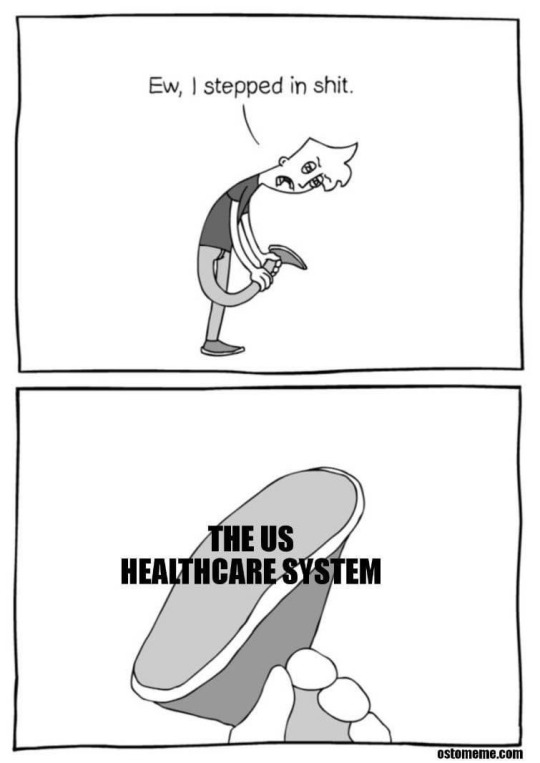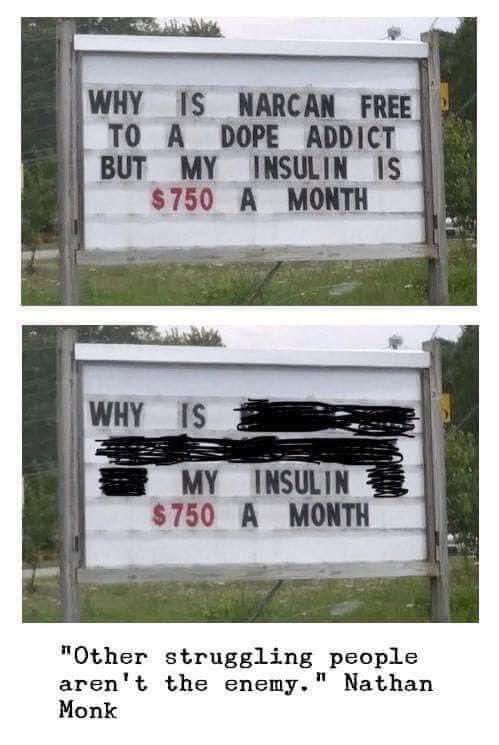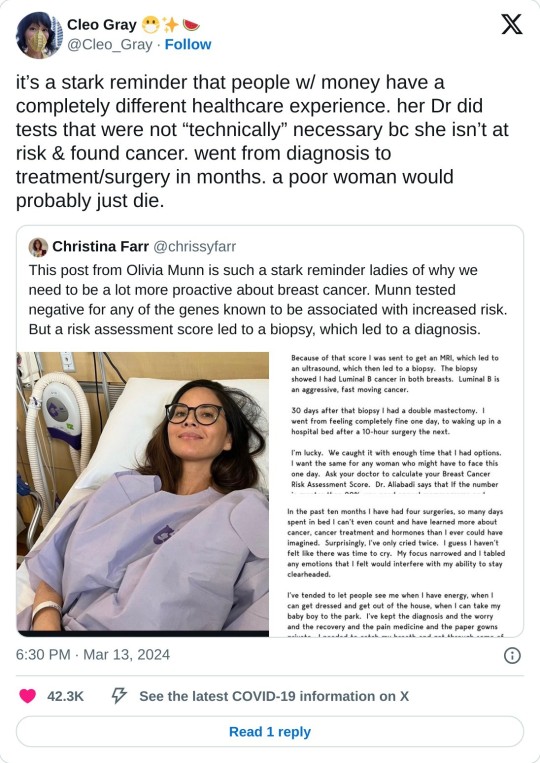#healthcare in the united states
Text
These fuckers voted “NO” on a $35 cost cap on insulin.

681 notes
·
View notes
Text
$11k
I had $11,000.00 of medicine (IVIg) in my refrigerator last night. Now, after a 5-hour infusion, it is in my son. This happens every 10 weeks.
I have insurance, of course. And at this point in the year, no matter how high, we've met the deductible. So it is "free" for some definition of the word.
If we were ever to lose our insurance, we could probably keep treating him for a couple or few years before we'd lose our house and all of our savings. We'd be homeless, and he'd be in a wheelchair.
It's a sobering thought.
29 notes
·
View notes
Text



"If a pig catches both a human influenza A virus and an avian influenza A virus at the same time, it can spark a process known as viral reassortment — a genetic exchange in which flu viruses swap gene segments."
"Those swaps can introduce dramatic changes, producing a new virus with certain properties of a non-human strain coupled with the capacity to infect and spread between people."
"The death rate in humans may be upwards of 50 per cent, World Health Organization data suggests, though it's possible that milder infections are getting missed, skewing the case fatality ratio. Still, in a population that's never been exposed, the global impacts could be dire."
"More human cases could also be happening under the radar among farm workers who've moved to the U.S. from abroad, don't speak English as their first language, and may be hesitant to seek medical help, he added."
"So I think there's probably underreporting on both sides," Armstrong said."
"If [H5N1] gets into a population where there's constantly animals going in and out … it might not ever leave."
I've been watching this develop for the past several days, and apart from being terrified most people will not take this seriously (I've seen a handful of people already shout conspiracy on social media and it's alarming to see, as always). What I wanted to point out is that pandemics are going to continue to be our 'normal.' I watched a great video on YouTube a while ago (I believe it was by Vice?) that touched base on how this is going to become our new reality because of multiple factors (such as our proximity to animals, and environments/etc). It was when Covid hit and they did a piece debunking some of the misinformation floating on the internet. If I can find it I will post it here because it was informative and relevant to pretty much any world crisis we will see around any virus that spreads among a human population.
This post isn't trying to fear monger anyone, I just hope more people are aware of what is happening because this is important to talk about. There are already cases (of cows getting this bird flu) in the US, and I won't be surprised if there will be instances in more countries around the world. As usual, keep washing your hands/keeping good hygiene practices, masking up (and if you aren't I hope you consider it), and taking precautions if you do happen to visit/work or go near a pig or poultry farm too:
I'll keep track of this here of course, but please stay informed folks. And also FU to any governments who will try to minimize this or try to diminish the severity until it's too late and community spread happens like Covid because their actions are influenced by capitalistic interests.
Update (April 7th, 2024, 9:32pm EST): to anyone wondering where some of the source information originates from -here is a link to the CDC. They are tracking documented avian virus outbreaks in the US and the public can access it here:
#current news#current events#global news#united states#cattle#cows#cattle farming#avian flu#bird flu#h5n1#mask up#pandemic#covid#covid isn't over#covid conscious#covid is airborne#covid is not over#viruses#fuck capitalism#anti captialism#healthcare#public health#world health organization#cdc#news update#update
15K notes
·
View notes
Text
"The Biden Administration last week [early December, 2023] announced it would be seizing patents for drugs and drug manufacturing procedures developed using government money.
A draft of the new law, seen by Reuters, said that the government will consider various factors including whether a medical situation is leading to increased prices of the drug at any given time, or whether only a small section of Americans can afford it.
The new executive order is the first exercise in what is called “march-in-rights” which allows relevant government agencies to redistribute patents if they were generated under government funding. The NIH has long maintained march-in-rights, but previous directors have been unwilling to use them, fearing consequences.
“We’ll make it clear that when drug companies won’t sell taxpayer funded drugs at reasonable prices, we will be prepared to allow other companies to provide those drugs for less,” White House adviser Lael Brainard said on a press call.
But just how much taxpayer money is going toward funding drugs? A research paper from the Insitute for New Economic Thought showed that “NIH funding contributed to research associated with every new drug approved from 2010-2019, totaling $230 billion.”
The authors of the paper continue, writing “NIH funding also produced 22 thousand patents, which provided marketing exclusivity for 27 (8.6%) of the drugs approved [between] 2010-2019.”
How we do drug discovery and production in America has a number of fundamental flaws that have created problems in the health service industry.
It costs billions of dollars and sometimes as many as 5 to 10 years to bring a drug to market in the US, which means that only companies with massive financial muscle can do so with any regularity, and that smaller, more innovative companies can’t compete with these pharma giants.
This also means that if a company can’t recoup that loss, a single failed drug can result in massive disruptions to business. To protect themselves, pharmaceutical companies establish piles of patents on drugs and drug manufacturing procedures. Especially if the drug in question treats a rare or obscure disease, these patents essentially ensure the company has monoselective pricing regimes.
However, if a company can convince the NIH that a particular drug should be considered a public health priority, they can be almost entirely funded by the government, as the research paper showed.
Some market participants, in this case the famous billionaire investor Mark Cuban, have attempted to remedy the issue of drug costs in America by manufacturing generic versions of patented drugs sold for common diseases."
-via Good News Network, December 11, 2023
#united states#us politics#biden administration#executive order#prescription drugs#medical news#healthcare#healthcare access#biden#big pharma#drug prices#public health#nih#national institutes of health#good news#hope
10K notes
·
View notes
Text

#fuck the supreme court#every day i wake up#ramblings#adam driver#adam driver memes#abortion is healthcare#reproductive rights#memes#united states#roe v wade#feminism#marriage story
41K notes
·
View notes
Text
A big cost and concern for many seniors in the U.S. is the price of prescription drugs and other healthcare expenses—and this year, thanks to The Inflation Reduction Act, their costs may go down dramatically, especially for patients fighting cancer or heart disease.
I learned about the new benefits because my ‘Medicare birthday’ is coming up in a couple months when I turn 65. I was shocked that there were so many positive changes being made, which I never heard about on the news.
Thousands of Americans on Medicare have been paying more than $14,000 a year for blood cancer drugs, more than $10,000 a year for ovarian cancer drugs, and more than $9,000 a year for breast cancer drugs, for instance.
That all changed beginning in 2023, after the Biden administration capped out-of-pocket prescriptions at $3,500—no matter what drugs were needed. And this year, in 2024, the cap for all Medicare out-of-pocket prescriptions went down to a maximum of $2,000.
“The American people won, and Big Pharma lost,” said President Biden in September 2022, after the legislation passed. “It’s going to be a godsend to many families.”
Another crucial medical necessity, the shingles vaccine, which many seniors skip because of the cost, is now free. Shingles is a painful rash with blisters, that can be followed by chronic pain, and other complications, for which there is no cure
In 2022, more than 2 million seniors paid between $100 and $200 for that vaccine, but starting last year, Medicare prescription drug plans dropped the cost for shots down to zero.
Another victory for consumers over Big Pharma affects anyone of any age who struggles with diabetes. The cost of life-saving insulin was capped at $35 a month [for people on Medicare].
Medicare is also lowering the costs of the premium for Part B—which covers outpatient visits to your doctors. 15 million Americans will save an average of $800 per year on health insurance costs, according to the US Department of Health and Human Services.
Last year, for the first time in history, Medicare began using the leverage power of its large patient pool to negotiate fair prices for drugs. Medicare is no longer accepting whatever drug prices that pharmaceutical companies demand.
Negotiations began on ten of the most widely used and expensive drugs.
Among the ten drugs selected for Medicare drug price negotiation were Eliquis, used by 3.7 million Americans and Jardiance and Xarelto, each used by over a million people. The ten drugs account for the highest total spending in Medicare Part D prescription plans...
How are all these cost-savings being paid for?
The government is able to pay for these benefits by making sure the biggest corporations in America are paying their fair share of federal taxes.
In 2020, for instance, dozens of American companies on the Fortune 500 list who made $40 billion in profit paid zero in federal taxes.
Starting in 2023, U.S. corporations are required to pay a minimum corporate tax of 15 percent. The Inflation Reduction Act created the CAMT, which imposed the 15% minimum tax on the adjusted financial statement income of any corporation with average income that exceeds $1 billion.
For years, Americans have decried the rising costs of health care—but in the last three years, there are plenty of positive developments.
-via Good News Network, February 25, 2024
#united states#medicare#healthcare#healthcare access#big pharma#prescription drugs#health insurance#us politics#good news#hope#seniors#aging#healthy aging
1K notes
·
View notes
Text
the US of A is certainly the most country of all time

296 notes
·
View notes
Text

73 notes
·
View notes
Text
14 notes
·
View notes
Text

3K notes
·
View notes
Text

Capitalism is killing people in so many ways, and the medical industrial complex is one of them. Healthcare should always be a universal right -both fair and equitable access, but in many cases it is not... the mass injustices.
#feminist#social justice#current events#current news#public health#health care#medical care#health and wellness#healthcare#medical industrial complex#medical industry#capitalism is evil#capitalism kills#abolish capitalism#capitalism#treatment#classism#poverty#systemic inequality#systemic injustice#united states
282 notes
·
View notes
Text
Less than three months after U.S. Senator Tammy Baldwin and her colleagues launched an investigation into the four major American manufacturers of inhalers, three of the companies have relented, making commitments to cap costs for their inhalers at $35 for patients who now pay much more.
25 million Americans have asthma and 16 million Americans have chronic obstructive pulmonary disease (COPD), meaning over 40 million Americans rely on inhalers to breathe.
Inhalers have been available since the 1950s, and most of the drugs they use have been on the market for more than 25 years.
According to a statement from the Wisconsin Senator’s office, inhaler manufacturers sell the exact same products at a much lower costs in other countries. One of AstraZeneca’s inhalers, Breztri Aerosphere, costs $645 in the U.S.—but just $49 in the UK. Inhalers made by Boehringer Ingelheim, GlaxoSmithKline, and Teva have similar disparities.
Baldwin and her Democratic colleagues—New Mexico Sen. Ben Ray Luján, Massachusetts Sen. Ed Markey, and Vermont Sen. Bernie Sanders—pressured the companies to lower their prices by writing letters to GSK, Boehringer Ingelheim, Teva, and AstraZeneca requesting a variety of documents that show why such higher prices are charged in America compared to Europe.
As a ranking member of the Senate Committee on Health, Education, Labor, and Pensions, Baldwin recently announced that as a result of the letters they had secured commitments from three of the four to lower the out-of-pocket costs of inhalers to a fixed $35.00 rate.
“For the millions of Americans who rely on inhalers to breathe, this news is a major step in the right direction as we work to lower costs and hold big drug companies accountable,” said Senator Baldwin.
A full list of the inhalers and associated drugs can be viewed here.
It’s the second time in the last year that pharmaceutical companies were forced to provide reasonable prices—after the cost of insulin was similarly capped successfully at $35 per month thanks to Congressional actions led by the White House.
-via Good News Network, March 25, 2024
#united states#us politics#us senate#tammy baldwin#bernie sanders#big pharma#health care#us healthcare#inhaler#asthma#pulmonary disease#healthcare access#affordability#disability#good news#hope
4K notes
·
View notes
Text
I am on government insurance (Medicaid). Out of pocket, my psychologist's rate is $225 an hour. He went through a decade or more of school, obtained a PhD, and graduated with student loan debt. He didn't state how much, but I can imagine it's likely in the hundreds of thousands considering he still has this debt and graduated with his PhD in the early 2000s.
He shared with me that out of that $225 rate, he obtains about $25 from one Medicaid client's insurance company. The insurance company pockets the rest. My friend, another therapist, has a similar story. She makes $75 off of Medicaid clients usually when her rate out of pocket is $200.
Most therapists, psychologists, and psychiatrists are no longer accepting Medicaid/Medicare insurances because of this reason, which people who are poor are on. Over half of mental health professionals are no longer accepting insurance, period. I think we all understand that low-income people and low-income communities struggle the most with mental health issues, and if you are a person of color in the US you are more likely to be low-income. If you are a domestic violence survivor turned homeless because you left your significant other, you are also more likely to be on Medicaid. If you are a first generation student, you are most likely on Medicaid. If you are formerly incarcerated, you are most likely on Medicaid. And so on.
Additionally, if you are a human being of the female sex, you are far more likely to seek out therapy than someone of the male sex. Overwhelmingly men don't seek out therapy unless their female significant partner pleads with them, pressures them, or gives them an ultimatum which influences them to make an appointment. What does this mean when the vast majority of mass shooters, rapists, pedophiles, and domestic violence abusers are male?

Figure 2. Percentage of adults aged 18 and over who had received any mental health treatment, taken medication for their mental health, or received counseling or therapy from a mental health professional in the past 12 months, by sex: United States, 2019
Pair all of these details with the fact that mental health professionals are in such high demand right now, that even with private insurance the wait list is anywhere from three to six months out. Insurance agencies are business, and the corruption inherent. Many focus on prioritizing coverage for acute crisis rather than treating long term underlying conditions (which in turn prevents acute crises), don't provide coverage for co-occurring conditions, are advertising that more providers are accepting their insurance than there actually are, and are solely driven by financial interest.
I wonder how much domestic violence, sexual violence, child abuse, poverty, hate crimes, generational trauma, and overall suffering within individuals and in their societies can be reduced by valuing mental health and holding insurance companies accountable for their financial exploitation.
We talk about the US healthcare crisis without talking about the US mental health crisis.
#mental health#therapy#psychology#behavioral health#social work#capitalism#late stage capitalism#poverty#inequality#healthcare#United States healthcare
341 notes
·
View notes
Text

#the USA healthcare system is a joke#current events#social justice#human rights#usa#spain#healthcare#medicine#medical facts#medical tag#political#political posting#politics#us politics#usa politics#united states politics#american politics#fuck the usa#fuck the us government#fuck the united states#europe#world politics#late stage capitalism#capitalism#anti capitalism#america is a failed state#america is a hellscape#health#health and wellness#health tips
57 notes
·
View notes
Video
💊💵
#video#tiktok#tiktoks#wtf#usa#united states#united states of america#healthcare#meds#medicine#medication#ballet_felice
425 notes
·
View notes